...And ANN Got A Ride!
by ANN Correspondent Aleta Vinas
As a journalist you can generally get places others
can’t... and other times, it’s just luck. In that vein,
new Aero-TV Video Journalist Peter Riley and I recently scored a
ride in the Goodyear Blimp at Oshkosh 2007. I would like to pay
homage to the television news crew who cancelled to make our ride
possible.

As if that wasn't enough luck... I then found one of the
five pilots rotating throughout the week is an Embry-Riddle
Aeronautical University Alumni. You give the secret Embry-Riddle
handshake and you’re chatting like friends, learning the
intricacies of being a blimp pilot. I am polishing my resume.
Matthew St. John graduated with a BS degree in Aeronautical
Science from Embry-Riddle in 1996 and even though one of the
Goodyear blimps is stationed at Pompano Beach, FL where many days
of touch and go’s are done, St. John never thought about
becoming a blimp pilot.
After graduation St. John had difficulties finding a flying job
so he went to Jacksonville, FL and fell back on an old hobby --
sailing. He was teaching young kids to sail at a yacht club.
“I ran into an old friend of mine and he asked how come I
never thought about blimps?” The friend worked for an airship
company and provided St. John with the contacts and info he
needed.
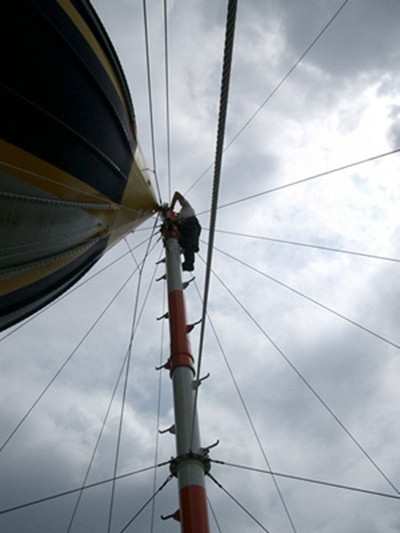
The transition from airplane to blimp “was a little
weird," according to St. John. “You learn to fly with the
pedals, you‘re doing yaws left and right.” To climb and
dive the pilots use a large elevator wheel at the side of the seat.
In a blimp helium pressure is important “we watch helium
pressure like an airplane pilot would watch an airspeed
indicator.” The helium pressure is maintained through
inflation and deflation of ballonets one located in the nose and
tail filled with air.
“One of my favorites was learning how to land a blimp
without any elevators,” comments St. John. “You can do
that with the ballonets, if you leave your power set you can
actually put a little air in the nose to bring the nose down and as
you start to get closer to the ground you can put a little more air
in the tail. Then you learn how to dump helium, in this case, to
make yourself a little bit heavier for the ground rollout for the
crew to pick you up.”
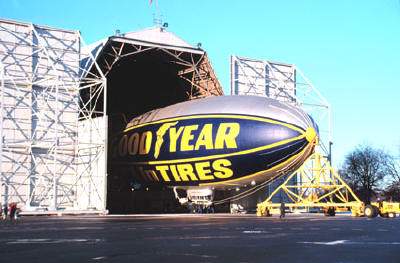
Maneuvering on the ground is one of the most critical phases of
flight -- the one gondola wheel has no brakes, and you use
asymmetrical thrust to maneuver to help the crew on the ground.
“We minimize our ground time, once we get off the ground back
up in the air we’re in our safe zone,” says St. John.
This is the opposite of other craft.
There is no blimp simulator, which presents a bit of a problem.
Training takes place in the blimps. “There’s only one
set of controls so whoever the instructor is sitting on the right
side he’s probably sweating bullets while teaching the
student how to land and it’s a very slow process,” St.
John jokes.
Blimp training varies anywhere from 4 months to a year depending
on the schedule. If there are TV event coverage or VIP’s
training gets put aside. Blimp pilot openings are rare, and they
stay within the company.

The Goodyear Blimp has taken almost 20 years to get to Oshkosh
-- no, it’s not really that slow. The 192 foot long, 60 foot
tall, blue, silver and yellow behemoth cruises at a brisk 30 mph in
the range of 1,000 to 3,000 feet AGL.
Most of the time viewers see the blimp over a stadium, this week
at Oshkosh, while not flying around visitors will be able to look
at the Spirit of Goodyear up close. Pioneer Airport by the EAA
Museum will be it’s home for viewers.
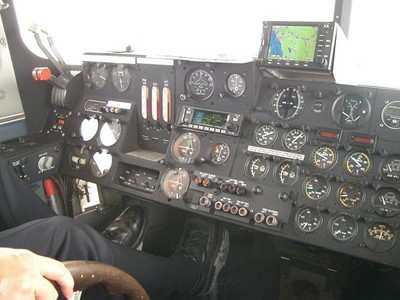
The last visit by one of Goodyear’s icons was 1988. The
Spirit of Goodyear wasn’t even born then. Spirit of Goodyear
came into service in March 2000. It makes its home at
Goodyear’s Wingfoot Lake Airship facility in Suffield, OH.
The creation of a blimp takes six months and life expectance is 12
to 14 years. It takes 202,000 cu ft of helium to inflate her
girlish figure and less than three hours to do it.
What happens to a blimp when it’s ready to retire? Blimp
pilots are comedians. “We got a big farm, up there at
Wingfoot Lake we just let it go up there and run around for the
rest of its days.” St. John gets serious and explains each
gondola is taken out of service and rebuilt and refurbished from
the ground up at the Wingfoot Lake facility. There’s always
one in rotation waiting for the next envelope.
The naming of their blimps is a very serious and personal
business. Each name represents something important to Goodyear or
the name is chosen to bring recognition to a proud tradition. The
Spirit of Goodyear name was chosen to honor the employees of the
Goodyear Tire and Rubber Company.
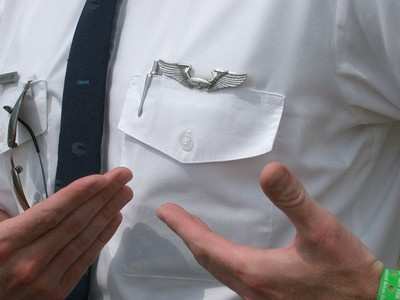
Goodyear’s current US blimp fleet consists of three ships;
Spirit of America based in City of Carson, CA; Spirit of Goodyear
based in Akron, OH; and Spirit of Innovation based in Pompano
Beach, CA.
Safety is utmost on the flight and on the ground in preparation
for the flight. St. John keeps the group in a compact herd as he
constantly eyes the blimp as it comes in for a landing, shifting us
as necessary to make for a quick ingress but far enough to avoid
any of the cables used to hold the blimp down.
The airship is not tied down or even stopped when passengers are
let in or out. There are almost two dozen ground support personnel
“holding the blimp on the ground.” Please picture a
Macy’s Thanksgiving Day parade balloon with less people...
and way more balloon.
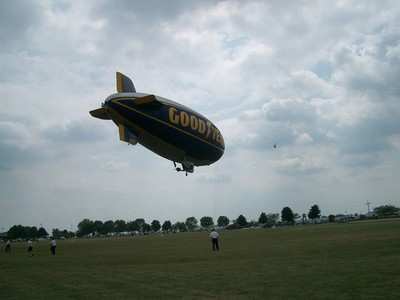
As we were ushered to the stairs they move to and fro a bit,
reminding me of the moving staircase at a carnival funhouse.
Juggling microphone, camera and reporter pad I plop not so
gracefully into the co-pilot seat. I didn’t scam the co-pilot
seat because of the Embry-Riddle “handshake”, -- since
the blimp is flying one pilot operations, someone gets to sit there
and I asked.
The pilots work in shifts and St. John stays on the ground to
herd the next lucky group to the “staging” area. Greg
Poppenhouse is our pilot for this flight. Poppenhouse is
Pilot-In-Charge, also known as Chief Pilot. We don our headsets to
cut the noise and be able to converse. It is quite noisy in the
blimp; the engines and propellers are right outside the
gondola.
The blimp has a unique take-off -- the ground crew pretty much
bounces it into the air. Boing, boing and away we go pitching up at
an angle fixed wing prop planes never dream of. Poppenhouse never
even needs to talk to the tower, the blimps route is prescribed and
the tower knows the boundaries and it is away from any of the
airport traffic. Of course, Poppenhouse monitors the frequencies,
just in case. We level off and Poppenhouse shows us a bit more of
the nose high and low attitudes. He mentions if we feel a bit
queasy to go ahead and fasten up those seat belts. Jokes on us,
there are no seatbelts; apparently a comedic talent is a must for
blimp pilots.
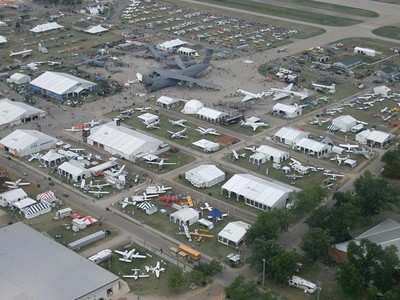
The 20 minute flight was jaw-dropping, the view was wonderful.
We cruised at about 20 mph and watched the cars passing us. Even an
LSA could speed past us in a race but it just didn’t matter.
Lumbering along in a blimp is just an experience all its own. These
days most of us are in rush mode, a blimp ride pulls you into laid
back mode. We circled back over the field and the expanse of
AirVenture unfolded in slow motion below.
We angled toward the ground at the V configuration of the ground
personnel, the V formation serves as a personal windsock to the
pilot.
St. John says “Everybody shares the same passion for these
big aerial ambassadors.” I would like to add, especially once
you taken a ride in one.
By the way... we have a VJ looking to luck out into a ride in a
Black Hawk...
 NTSB Final Report: Cessna 177B
NTSB Final Report: Cessna 177B ANN's Daily Aero-Term (05.08.25): Final Approach Fix
ANN's Daily Aero-Term (05.08.25): Final Approach Fix Aero-News: Quote of the Day (05.08.25)
Aero-News: Quote of the Day (05.08.25) ANN's Daily Aero-Term (05.09.25): Estimated (EST)
ANN's Daily Aero-Term (05.09.25): Estimated (EST) ANN's Daily Aero-Linx (05.09.25)
ANN's Daily Aero-Linx (05.09.25)










